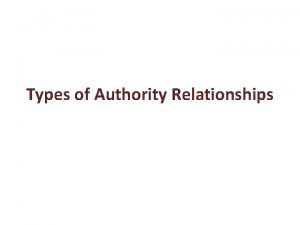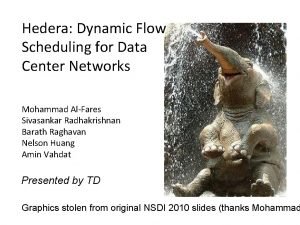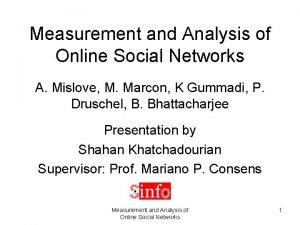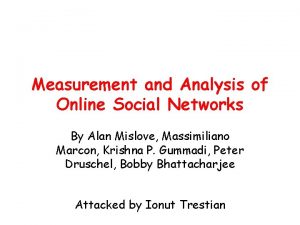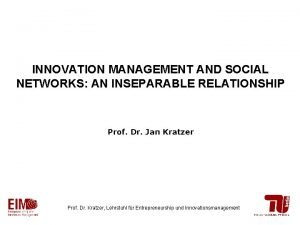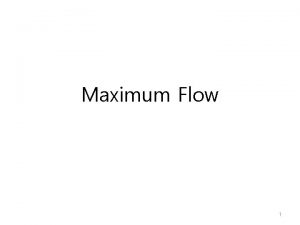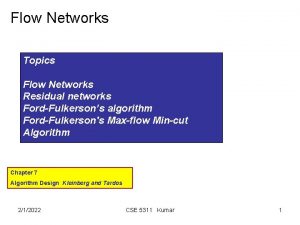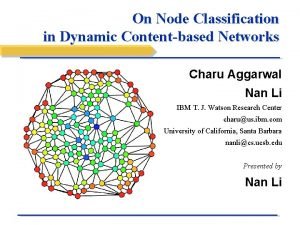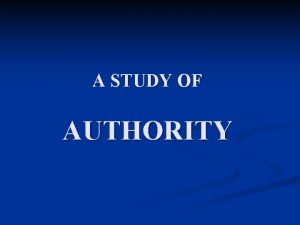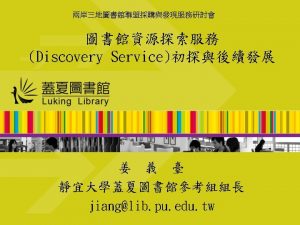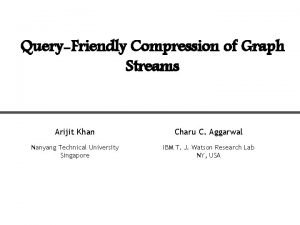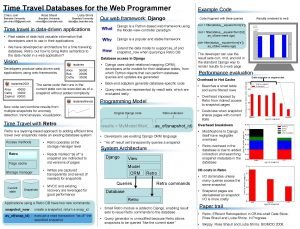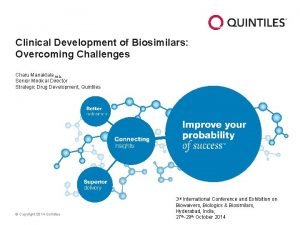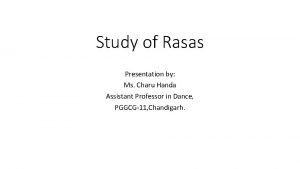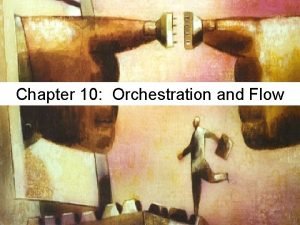ON FLOW AUTHORITY DISCOVERY IN SOCIAL NETWORKS Charu


























- Slides: 26

ON FLOW AUTHORITY DISCOVERY IN SOCIAL NETWORKS Charu C. Aggarwal Arijit Khan, Xifeng Yan IBM T. J. Watson Research Computer Science Center, Hawthorne, University of California, New York Santa Barbara charu@us. ibm. com {arijitkhan, xyan}@cs. ucsb. edu

On Flow Authority Discovery in Social Networks MOTIVATION v Online Marketing via “word-ofmouth” recommendations. v Find a small subset of influential individuals in a social network, such that they can influence the largest number of people in the network. 2 Charu C. Aggarwal, Arijit Khan and Xifeng Yan

On Flow Authority Discovery in Social Networks MOTIVATION v Fast and widespread information cascade, i. e. , with the use of Facebook and Twitter, the event “ 2011 Egyptian Protest” quickly reached to the protestors worldwide. Influence Propagation in Social Network Charu C. Aggarwal, Arijit Khan and Xifeng Yan 3

On Flow Authority Discovery in Social Networks ROADMAP v Problem Formulation v Related Work v Algorithm ü ü Ranked Replace Bayes Traceback v Restricted Source and Targets v Experimental Results v Conclusion 4 Charu C. Aggarwal, Arijit Khan and Xifeng Yan

On Flow Authority Discovery in Social Networks PROBLEM FORMULATION v Directed Graph G (V, E, P). v P : E {0, 1}; probability of information cascade through a directed edge. v Let pij be the probability of information cascade along directed edge eij. Then, P = [pij]. v If ri be the probability that a given node i contains an information, then it eventually transmits the information to adjacent node j with probability (ri ˟ pij). ri i pij ri j 1 -pij i j Influence Cascade Model 1 -ri i Charu C. Aggarwal, Arijit Khan and Xifeng Yan j 5

On Flow Authority Discovery in Social Networks PROBLEM DEFINITION v v Let be the steady state probability that node i assimilates the information. pli S is the initial set of seed nodes, where the information was exposed. q Problem Definition: Influence Cascade Model Given the budget constraint k, determine the set S of k nodes which maximizes the total aggregate flow 6 Charu C. Aggarwal, Arijit Khan and Xifeng Yan

On Flow Authority Discovery in Social Networks ROADMAP v Problem Formulation v Related Work v Algorithm - Ranked Replace - Bayes Traceback v Restricted Source and Targets v Experimental Results v Conclusion Charu C. Aggarwal, Arijit Khan and Xifeng Yan

On Flow Authority Discovery in Social Networks RELATED WORK v Kempe, Kleinberg, Tardos. KDD ‘ 03: ü Linear Threshold Model – o ü Independent Cascade Model o Each newly active node i gets a single chance to activate its inactive neighbor node j and succeed with probability pij. o v Degree Discount Independent Cascade Model. Wang, Kong, Song, Xie. KDD ‘ 10: ü v Greedily select the best possible seed node given the already selected seed nodes. Chen, Wang, Yang. KDD ‘ 09: ü v A node gets activated at time t if more than a certain fraction of its neighbors were active at time t-1. Community Based Greedy Algorithm for Influential Nodes Detection. Lappas, Terzi, Gunopulos, Mannila. KDD ‘ 10: ü K-effectors that maximizes influence on a given set of nodes and minimizes the influence outside the set. 8 Charu C. Aggarwal, Arijit Khan and Xifeng Yan

On Flow Authority Discovery in Social Networks ROADMAP v Problem Formulation v Related Work v Algorithm - Ranked Replace - Bayes Traceback v Restricted Source and Targets v Experimental Results v Conclusion 9 Charu C. Aggarwal, Arijit Khan and Xifeng Yan

On Flow Authority Discovery in Social Networks RANKED REPLACE ALGORITHM v Iterative and heuristic technique. v Initialization: - Calculate the steady state flow (SSF) by each node u in V, which is defined as the aggregate flow generated by node u individually. SSF(u) = ; when S = {u}. - Sort all nodes in V in descending order of their steady state flow. v Preliminary Seed Selection: - Select the k nodes with highest SSF values as the preliminary seed nodes in S. 10 Charu C. Aggarwal, Arijit Khan and Xifeng Yan

On Flow Authority Discovery in Social Networks RANKED REPLACE ALGORITHM C ( ONTINUED) v Iterative Improvement of Seed Nodes: - Replace some node in S with a node in (V-S), if that increases the total aggregate flow. - The seed nodes in S are replaced in increasing order of their SSF values. SSF S - The nodes from (V-S) are selected in decreasing order of their SSF values. - If r successive attempts of replacement do not increase the aggregate flow, terminate and return S. V-S Charu C. Aggarwal, Arijit Khan and Xifeng Yan 11

On Flow Authority Discovery in Social Networks PROBLEM WITHRANKED REPLACE v Each iteration of Ranked Replace technique requires a lot of computation O(t. |E|); where t is the number of iterations required to get steady state probabilities. v Number of iterations required for convergence of Ranked Replace can be very large O(|V|). v Slow !!! 12 Charu C. Aggarwal, Arijit Khan and Xifeng Yan

On Flow Authority Discovery in Social Networks BAYES TRACEBACKALGORITHM v An information is viewed as a packet. v The packet at a node j is inherited from one of its incoming nodes i with probability proportional to pij following a random walk. v v v There is a single information packet, which is (stochastically) present only at one node at a time. 0. 2 S 0. 1 0. 5 0. 3 Expose the information packet to one of the k seed nodes. The token will visit the nodes in the network following random walk. Thus, it can visit a node multiple times. 0. 2 0. 5 Bayes Traceback Model 13 Charu C. Aggarwal, Arijit Khan and Xifeng Yan

On Flow Authority Discovery in Social Networks BAYES TRACEBACKMODEL (CONTINUED) v Transient State – Each node in the graph has equal probability of having the packet. v The even spread of information may not be possible in steadystate, however our goal is to create an evenly spread probability distribution as an intermediate transient after a small number of iterations following the random walk. v Identify k seed nodes, so that an intermediate transient state is reached as quickly as possible. v Intuitively, these k nodes correspond to the seed nodes which result in maximum aggregate flow in the network. 14 Charu C. Aggarwal, Arijit Khan and Xifeng Yan

On Flow Authority Discovery in Social Networks BAYES TRACEBACKALGORITHM v Starting from the transient state at t=0, trace back the previous states using Bayes Algorithm. v Q-t(i) = probability that node i has the information packet at time t. A 1. 0 0. 3 B 0. 4 C 0. 5 q Q-t(B)=0. 5 q Q-(t+1)(A) Q-t(C)=0. 3 = 0. 5*0. 3/(0. 3+0. 4+0. 5) + 0. 3*1. 0/(1. 0+0. 2) 0. 3 = 0. 38 0. 2 Bayes Traceback Method v At each iteration, delete a fraction of nodes with low probabilities of having the information packet. Iterate until end up with k nodes. Charu C. Aggarwal, Arijit Khan and Xifeng Yan 15

On Flow Authority Discovery in Social Networks RUNNING TIME OFBAYES TRACEBACK v Each iteration of Bayes Traceback has complexity O(|E|). v If we delete f fraction of the remaining nodes in each iteration, the number of iterations required by Bayes Traceback method is given by log(n/k)/log(1/(1 -f)). v Fast !!! 16 Charu C. Aggarwal, Arijit Khan and Xifeng Yan

On Flow Authority Discovery in Social Networks ROADMAP v Problem Formulation v Related Work v Algorithm - Ranked Replace - Bayes Traceback v Restricted Source and Targets v Experimental Results v Conclusion 17 Charu C. Aggarwal, Arijit Khan and Xifeng Yan

On Flow Authority Discovery in Social Networks RESTRICTEDSOURCE ANDTARGETS v Restricted Targets: maximize the flow in a given set of target nodes, although the entire graph structure can be used. v Restricted Source: The initial k seed nodes can be selected only among a given set of candidate nodes. v Solutions to both problems are straightforward for Ranked Replace algorithm. v For Restricted source problem in Bayes Traceback method, delete nodes until k nodes are left from the given set of candidate nodes. 18 Charu C. Aggarwal, Arijit Khan and Xifeng Yan

On Flow Authority Discovery in Social Networks RESTRICTEDSOURCE ANDTARGETS (CONTINUED) v For Restricted target problem in Bayes Traceback method, the target nodes are considered as sink nodes; i. e. , we do not propagate the flow from target node to non-target node, but we propagate flow from non-target to target sets. A Q-t(B)=0. 5 q Q-(t+1)(A) Q-t(C)=0. 3 1. 0 0. 3 B q C 0. 5 = 0. 5*0. 3/(0. 3+0. 4+0. 5) + 0. 3*1. 0/(1. 0+0. 2) 0. 3 = 0. 1 0. 4 0. 5 0. 2 Bayes Traceback with Restricted Target 19 Charu C. Aggarwal, Arijit Khan and Xifeng Yan

On Flow Authority Discovery in Social Networks ROADMAP v Problem Formulation v Algorithm - Ranked Replace - Bayes Traceback v Restricted Source and Targets v Experimental Results v Conclusion 20 Charu C. Aggarwal, Arijit Khan and Xifeng Yan

On Flow Authority Discovery in Social Networks EXPERIMENTALRESULTS v v Data Sets: # of Node # of Edges Last. FM 818, 800 3, 340, 954 DBLP 684, 911 7, 764, 604 Twitter 1, 194, 092 6, 450, 193 Top-5 Flow Authorities in DBLP: Ranked Replace Bayes Traceback Peer Influence Degree Discount IC Wen Gao Luigi Fortuna Wei Li Francky Catthor Philip S Yu Dipanwita R. C. Wei Wang Philip S Yu M T Kandemir Timothy Sullivan Li Zhang M T Kandemir Francky Catthor Wei Li Ian T Foster A L S Vincentelli S C Lin Wei Zhang 21 Charu C. Aggarwal, Arijit Khan and Xifeng Yan

On Flow Authority Discovery in Social Networks EFFECTIVENESSRESULTS v k = # flow authority nodes Effectiven ess Results (DBLP) 22 Charu C. Aggarwal, Arijit Khan and Xifeng Yan

On Flow Authority Discovery in Social Networks EFFICIENCY RESULTS v k = # flow authority nodes Efficiency Results (DBLP) 23 Charu C. Aggarwal, Arijit Khan and Xifeng Yan

On Flow Authority Discovery in Social Networks ROADMAP v Problem Formulation v Related Work v Algorithm - Ranked Replace - Bayes Traceback v Restricted Source and Targets v Experimental Results v Conclusion 24 Charu C. Aggarwal, Arijit Khan and Xifeng Yan

On Flow Authority Discovery in Social Networks CONCLUSION v Novel algorithms for the determination of optimal flow authorities in social networks. v Empirically outperform the existing algorithms for optimal flow authority detection in graphs. v Can be easily extended to the restricted source and target set problems. v How to modify the algorithms in the presence of negative information flows? 25 Charu C. Aggarwal, Arijit Khan and Xifeng Yan

On Flow Authority Discovery in Social Networks THANK YOU!!! QUESTIONS? 26 Charu C. Aggarwal, Arijit Khan and Xifeng Yan
 Charu mullick
Charu mullick Line authority means
Line authority means Virtual circuit and datagram network
Virtual circuit and datagram network Basestore iptv
Basestore iptv Hedera: dynamic flow scheduling for data center networks
Hedera: dynamic flow scheduling for data center networks Social media discovery
Social media discovery Apa itu social thinking
Apa itu social thinking Social thinking social influence social relations
Social thinking social influence social relations Measurement and analysis of online social networks
Measurement and analysis of online social networks Collaborating via social networks and groupware
Collaborating via social networks and groupware Measurement and analysis of online social networks
Measurement and analysis of online social networks Prof. dr. jan kratzer
Prof. dr. jan kratzer Finding a team of experts in social networks
Finding a team of experts in social networks Social media for asset managers
Social media for asset managers 6 liters of oxygen is what percentage
6 liters of oxygen is what percentage High flow versus low flow oxygen
High flow versus low flow oxygen O2 liters to fio2
O2 liters to fio2 Laminar flow meter
Laminar flow meter Internal and external flow
Internal and external flow Energy naturally flows from warmer matter to cooler matter.
Energy naturally flows from warmer matter to cooler matter. Flow of energy vs flow of matter
Flow of energy vs flow of matter Structure chart in software engineering
Structure chart in software engineering Data flow structure
Data flow structure Rotational and irrotational flow
Rotational and irrotational flow External flow vs internal flow
External flow vs internal flow Data flow vs control flow
Data flow vs control flow Cheese making flow chart
Cheese making flow chart

